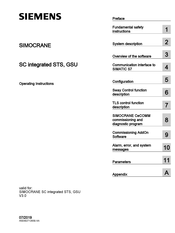Siemens SIMOTION D4x5-2 Manuals
Manuals and User Guides for Siemens SIMOTION D4x5-2. We have 2 Siemens SIMOTION D4x5-2 manuals available for free PDF download: Operating Instructions Manual, Commissioning And Hardware Installation Manual
Siemens SIMOTION D4x5-2 Operating Instructions Manual (446 pages)
Brand: Siemens
|
Category: Construction Equipment
|
Size: 15 MB
Table of Contents
-
Preface3
-
-
Introduction17
-
Applications18
-
-
-
Overview33
-
Dcc_Schoist38
-
Dcc_Sccamera46
-
Dcc_Sctls248
-
Dcc_Scintpo52
-
Dcc_Sccommon54
-
Dcc_Scdiag57
-
5 Configuration
109-
Requirement109
-
Performing Setup111
-
Execution System134
-
-
-
Activation150
-
Control150
-
Activation152
-
Control152
-
Activation155
-
Control155
-
Activation158
-
Control158
-
Control159
-
Controlled Stop164
-
Immersion Point166
-
Blocked Regions170
-
Lock Bits179
-
Soft Approach185
-
Selection193
-
Target Generator195
-
Requirement195
-
Parameterization196
-
Control196
-
Initialization196
-
Diagnostics200
-
Bay Scanner204
-
-
Slack Rope219
-
Override219
-
Hoist Takeover221
-
Use229
-
-
Requirements238
-
-
-
Installing263
-
Menu Bar267
-
Monitor (Tab)271
-
TLS Monitors277
-
Overview283
-
More Functions287
-
File Manager288
-
X/Y Diagram304
-
TLS Trace306
-
Logger309
-
Introduction309
-
-
-
Requirements319
-
Other Settings346
-
-
-
Error Messages373
-
Error List Addon374
-
Overview374
-
Other Errors 1384
-
Other Errors 2385
-
Error List TLS387
-
11 Parameters
393 -
Appendix
435-
References435
-
Variable Signals437
-
Glossary443
Advertisement
Siemens SIMOTION D4x5-2 Commissioning And Hardware Installation Manual (432 pages)
Brand: Siemens
|
Category: Control Unit
|
Size: 18 MB
Table of Contents
-
Preface3
-
-
3 Installing
35-
Fundamentals51
-
Requirements51
-
4 Connecting
55-
Power Supply63
-
Safety Rules63
-
Routing90
-
-
RESET Button101
-
Fan117
-
-
MPI Parameters143
-
Basic Principles148
-
-
Overview175
-
Overview203
-
Overview211
-
CX32-2 Power-Up220
-
Basic Principles275
-
-
Hub Properties296
-
Overview298
-
Deleting Data312
-
Overview318
-
-
Overview337
-
-
9 Diagnostics
379-
Overview396
-
Diagnostic Data396
-
Storing Data402
-
Overview404
-
ESD Guidelines423
Advertisement

